Application of Singularity Theory to the Distribution of Heavy Metals in Surface Sediments of the Zhongsha Islands
Abstract
:1. Introduction
2. Study Area
3. Methods
3.1. Analysis of Local Singularities
3.2. Multifractal Filtering Technology
3.3. The Principal Component Analysis Method
4. Data Section
5. Results and Discussion
5.1. Extraction of Weak Anomalies and Delineation of Prospective Areas
Analysis of Local Singularities and Delineation of Local Anomalies
5.2. Local Singularity Analysis and Combined Local Anomaly Delineation
5.3. Decomposition and Delineation of Compound Anomalies
6. Conclusions
Author Contributions
Funding
Institutional Review Board Statement
Informed Consent Statement
Data Availability Statement
Acknowledgments
Conflicts of Interest
References
- Wang, S.; Wang, S.; Liu, Y.; Wu, S. Tectonics and sedimentation of the Zhongsha trough basin: Implication to the basin evolution in distal rifting margin [J/OL]. Earth Sci. 2022, 47, 1094–1106. [Google Scholar]
- Chen, J.; Liu, S.; Wang, S.; Zhang, H.; Qin, Y.; Chen, W.; Wu, S. Characteristics and mechanism of the development of gravity flow deposits in Zhongsha Trough. Acta Sci. Nat. Univ. Sunyatseni 2022, 61, 39–54. [Google Scholar]
- Li, Y.; Huang, H.; Qiu, X.; Du, F.; Long, G.; Zhang, H.; Chen, H.; Wang, Q. Wide-angle and multi-channel seismic surveys in Zhongsha waters. Chin. J. Geophys. 2020, 63, 1523–1537. [Google Scholar]
- Zhao, B.; Gao, H.; Zhang, H.; Li, L. Structure study of the northeastern Zhongsha Trough Basin in the South China Sea based on prestack depth migration seismic imaging. J. Trop. Oceanogr. 2019, 38, 95–102. [Google Scholar]
- Yan, Q.; Shi, X.; Wang, K. Mineral provinces and matter source in surface sediments near the Zhongsha Islands in the South China Sea. Acta Oceanol. Sin. 2007, 29, 97–104. [Google Scholar]
- Yan, Q.; Wang, K.; Shi, X. Provinces and provenance of heavy minerals in surface sediments of the sea area near Zhongsha Islands in South China Sea. Mar. Geol. Quat. Geol. 2008, 28, 17–24. [Google Scholar]
- Zhang, J.; Peng, X.; Zhang, Y.; Wang, Y. Distribution of carbonate content in surface sediment from north of Zhongsha Islands to Northern slope in the South China Sea. Trop. Geogr. 2011, 31, 125–132. [Google Scholar]
- Wang, L.; Yu, K.; Wang, Y.; Wang, S.; Huang, X.; Zhang, R.; Wang, L. Distribution characteristic of heavy metals in coral reefs located in the Zhongsha Islands and Xisha Islands of South China Sea. Trop. Geogr. 2017, 37, 718–727. [Google Scholar]
- Michelutti, N.; Simonetti, A.; Briner, J.P.; Funder, S.; Creaser, R.A.; Wolfe, A.P. Temporal trends of pollution Pb and other metals in east-central Baffin Island inferred from lake sediment geochemistry. Sci. Total Environ. 2009, 407, 5653–5662. [Google Scholar] [CrossRef]
- Zhang, W.; Feng, H.; Chang, J.; Qu, J.; Xie, H.; Yu, L. Heavy metal contamination in surface sediments of Yangtze River intertidal zone: An assessment from different indexes. Environ. Pollut. 2009, 157, 1533–1543. [Google Scholar] [CrossRef]
- Hayaty, M.; Tavakoli Mohammadi, M.R.; Rezaei, A.; Shayestehfar, M.R. Risk Assessment and Ranking of Metals Using FDAHP and TOPSIS. Mine Water Environ. 2014, 33, 157–164. [Google Scholar] [CrossRef]
- Çevik, F.; Münir, Z.L.G.; Osman, B.D.; Fındık, Ö. An assessment of metal pollution in surface sediments of Seyhan dam by using enrichment factor, geoaccumulation index and statistical analyses. Environ. Monit. Assess. 2009, 152, 309–317. [Google Scholar] [CrossRef] [PubMed]
- Fu, F.; Wang, Q. Removal of heavy metal ions from waste waters: A review. J. Environ. Manag. 2011, 92, 407–418. [Google Scholar] [CrossRef]
- Rodríguez, L.; Ruiz, E.; Alonso-Azcárate, J.; Rincón, J. Heavy metal distribution and chemical speciation in tailings and soils around a Pb-Zn mine in Spain. J. Environ. Manag. 2009, 90, 1106–1116. [Google Scholar] [CrossRef]
- Christophoridis, C.; Dedepsidis, D.; Fytianos, K. Occurrence and distribution of selected heavy metals in the surface sediments of Thermaikos Gulf, N. Greece: Assessment using pollution indicators. J. Hazard. Mater. 2009, 168, 1082–1091. [Google Scholar] [CrossRef] [PubMed]
- Fang, H.; Chen, M.; Chen, Z. Environmental Characteristics and Models of Surface Sediments; Beijing Science Press: Beijing, China, 2009; pp. 1–3. [Google Scholar]
- Ali, R.; Hossein, H.; Seyedeh, B.F.M.; Sara, H.; Nima, J. Assessment of Heavy Metals Contamination in Surface Soils in Meiduk Copper Mine Area, SE Iran. Earth Sci. Malays. 2019, 3, 1–8. [Google Scholar]
- Ali, R.; Hossein, H.; Seyedeh, B.F.M.; Nima, J. Evaluation Of Heavy Metals Concentration In Jajarm Bauxite Deposit In Northeast Of Iran Using Environmental Pollution Indices. Malays. J. Geosci. 2019, 3, 12–20. [Google Scholar] [CrossRef]
- Limpert, E.; Stahel, W.A.; Abbt, M. Lognormal distributions across the sciences: Keys and clues. Bioscience 2001, 51, 341–352. [Google Scholar] [CrossRef]
- Xie, S.; Cheng, Q.; Xing, X.; Bao, Z.; Chen, Z. Geochemical multifractal distribution patterns in sediments from ordered streams. Geoderma 2010, 160, 36–46. [Google Scholar] [CrossRef]
- Zuo, R.; Wang, J. ArcFractal: An ArcGIS Add-In for Processing Geoscience Data Using Fractal/Multifractal Models. Nat. Resour. Res. 2020, 29, 3–12. [Google Scholar] [CrossRef]
- Buccione, R.; Mongelli, G.; Sinisi, R.; Boni, M. Relationship between geometric parameters and compositional data: A new approach to karst bauxites exploration. J. Geochem. Explor. 2016, 169, 192–201. [Google Scholar] [CrossRef]
- Xie, S.; Bao, Z. Fractal and multifractal properties of geochemical fields. Math. Geol. 2004, 36, 847–864. [Google Scholar] [CrossRef]
- Agterberg, F. Mixtures of multiplicative cascade models in geochemistry. Nonlinear Process. Geophys. 2007, 14, 201–209. [Google Scholar] [CrossRef]
- Cheng, Q.; Agterberg, F.; Ballantyne, S. The separation of geochemical anomalies from background by fractal methods. J. Geochem. Explor. 1994, 51, 109–130. [Google Scholar] [CrossRef]
- Huang, J. Features of the Zhongsha Atoll in the South China Sea. Mar. Geol. Quat. Geol. 1987, 7, 23–26. [Google Scholar]
- Cheng, Q. Multifractality and spatial statistics. Comput. Geosci. 1999, 25, 949–961. [Google Scholar] [CrossRef]
- Carranza, E.J.M.; Hale, M. Wildcat mapping of gold potential, Baguio district, Philippines. Trans. Inst. Min. Metall. B Appl. Earth Sci. 2002, 111, B100–B105. [Google Scholar] [CrossRef]
- Carranza, E.J.M. Improved wildcat modelling of mineral prospectivity. Resour. Geol. 2010, 60, 129–149. [Google Scholar] [CrossRef]
- Cheng, Q.; Bonham-Carter, G.; Wang, W.; Zhang, S.; Li, W.; Xia, Q. A spatially weighted principal component analysis for multi-element geochemical data for mapping locations of felsic intrusions in the Gejiu mineral district of Yunnan, China. Comput. Geosci. 2011, 37, 662–669. [Google Scholar] [CrossRef]
- Zhang, L.; Wang, G.; Yao, D.; Duan, G. Research and environmental significance of heavy metal in offshore sediment. Mar. Geol. Lett. 2003, 19, 6–9. [Google Scholar]
- Cheng, Q.; Zhao, P.; Chen, J.; Xia, Q.; Chen, Z.; Zhang, S.; Xu, D.; Xie, S.; Wang, W. Application of Singularity Theory in Prediction of Tin and Copper Mineral Deposits in Gejiu District, Yunnan, China: Weak Information Extraction and Mixing Information Decomposition. Earth Sci.-J. China Univ. Geosci. 2009, 34, 232–242. [Google Scholar]
- Cicchella, D.; De Vivo, B.; Lima, A.; Albanese, S.; McGill, R.A.R.; Parrish, R.R. Heavy metal pollution and Pb isotopes in urban soils of Napoli. Ital. Geochemistry: Exploration, Environment. Analysis 2008, 8, 103–112. [Google Scholar]

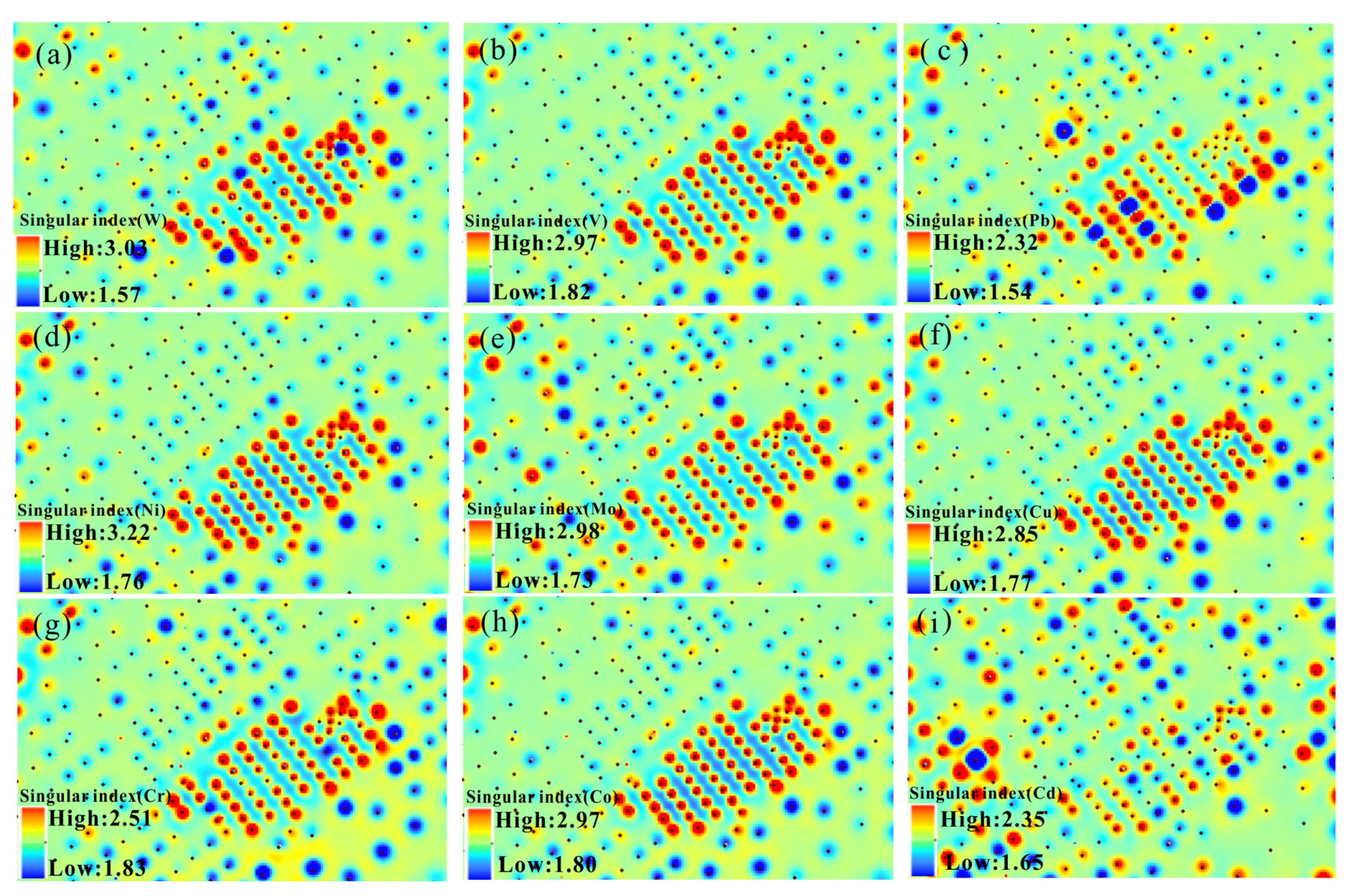
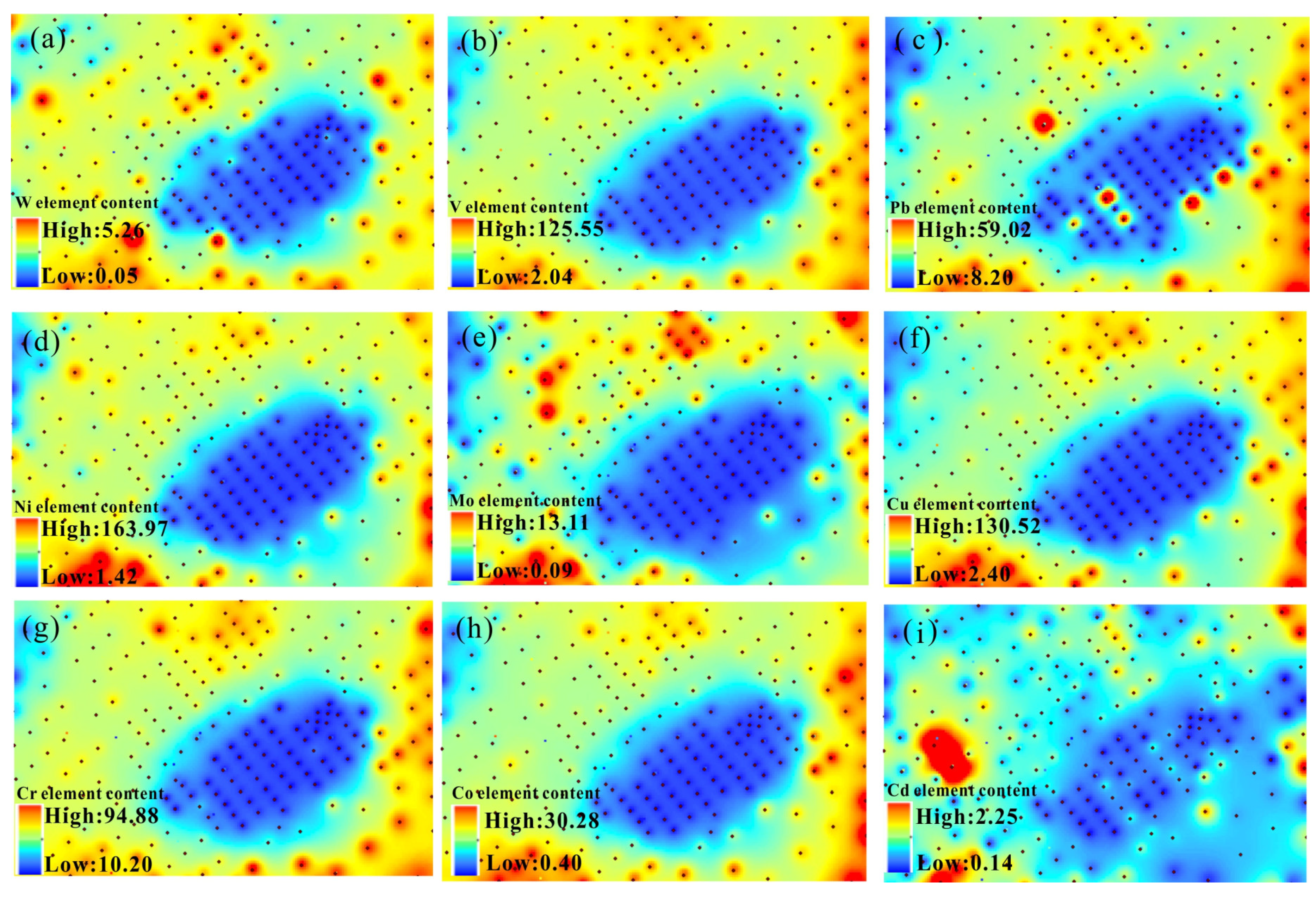
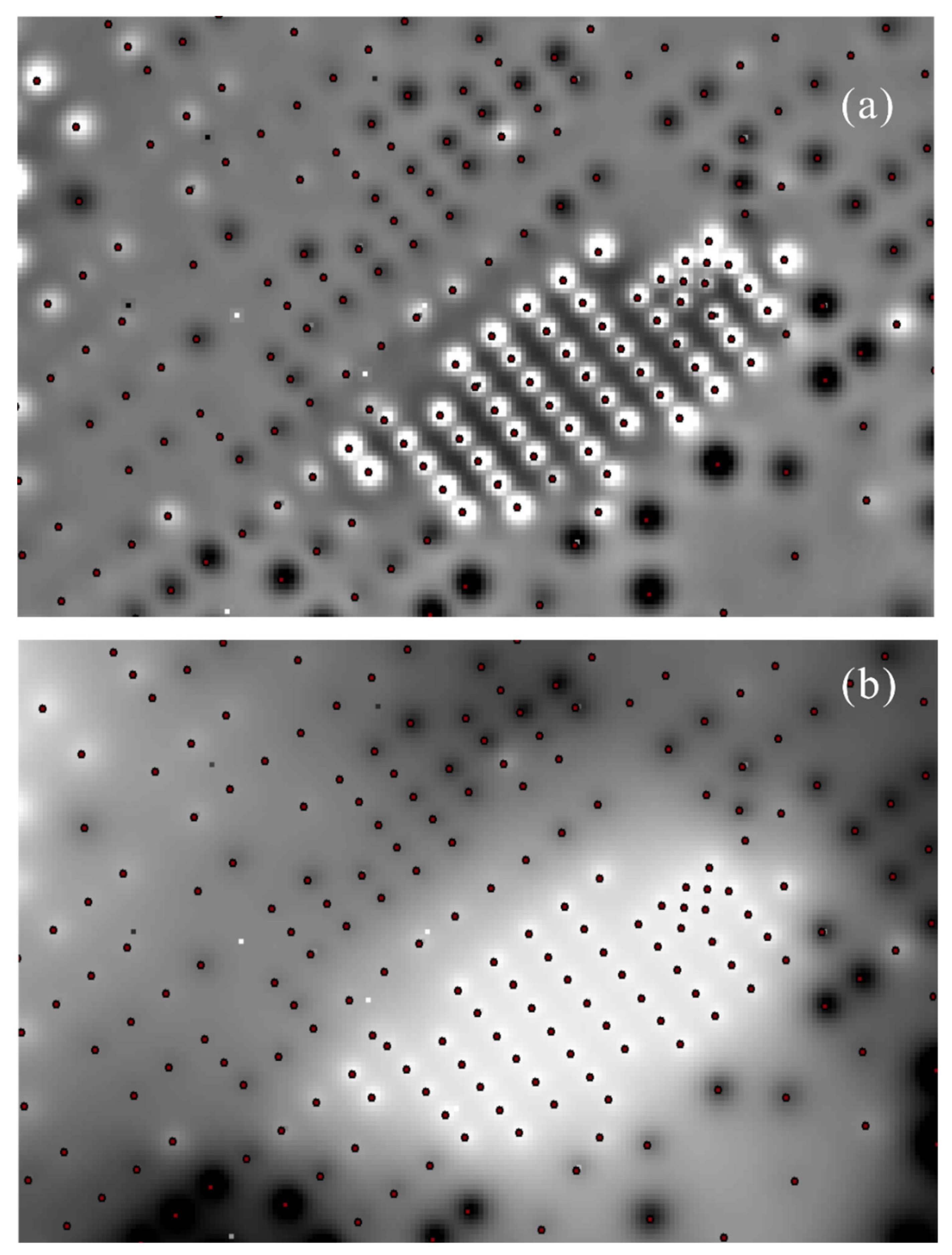
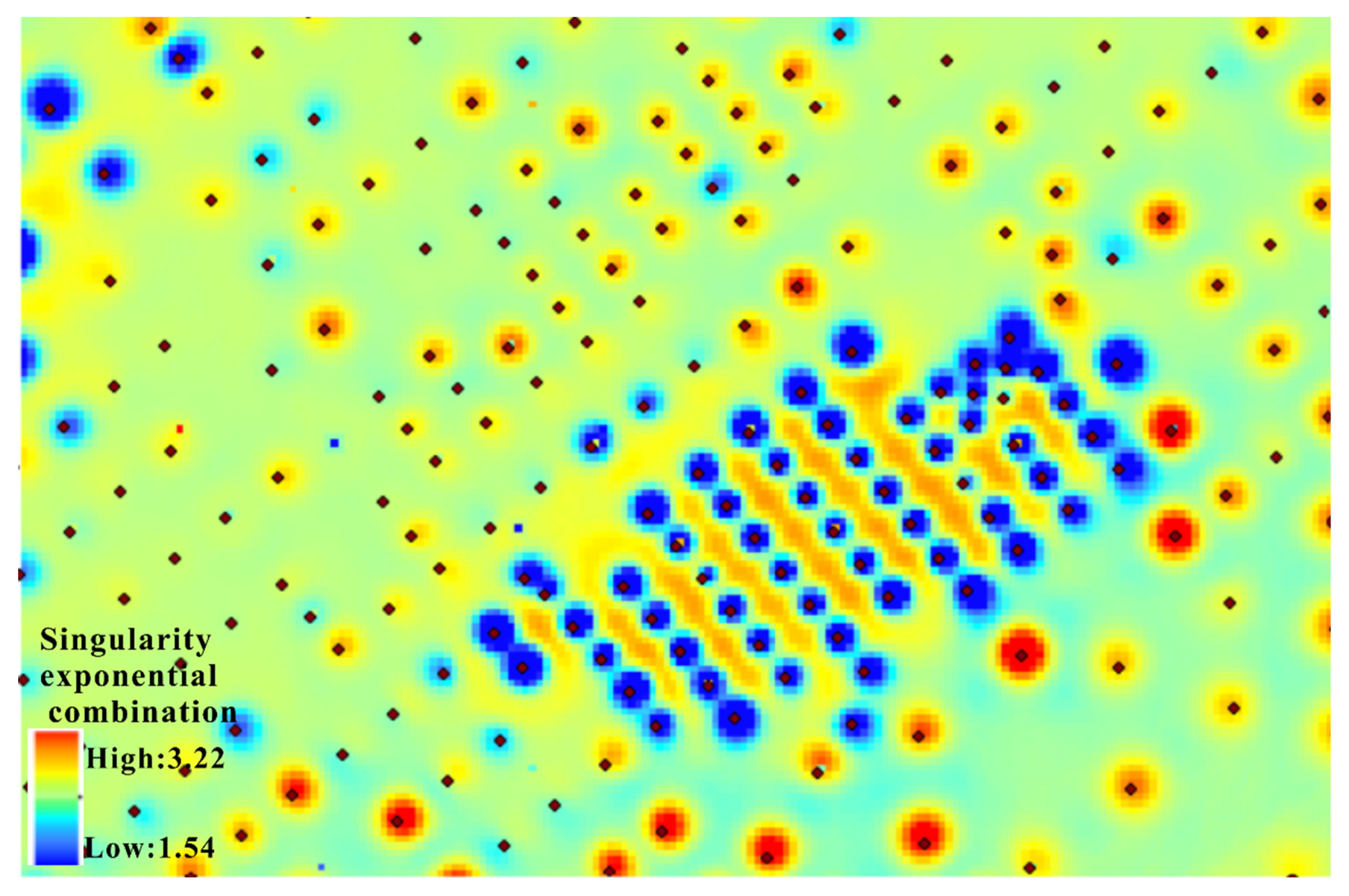
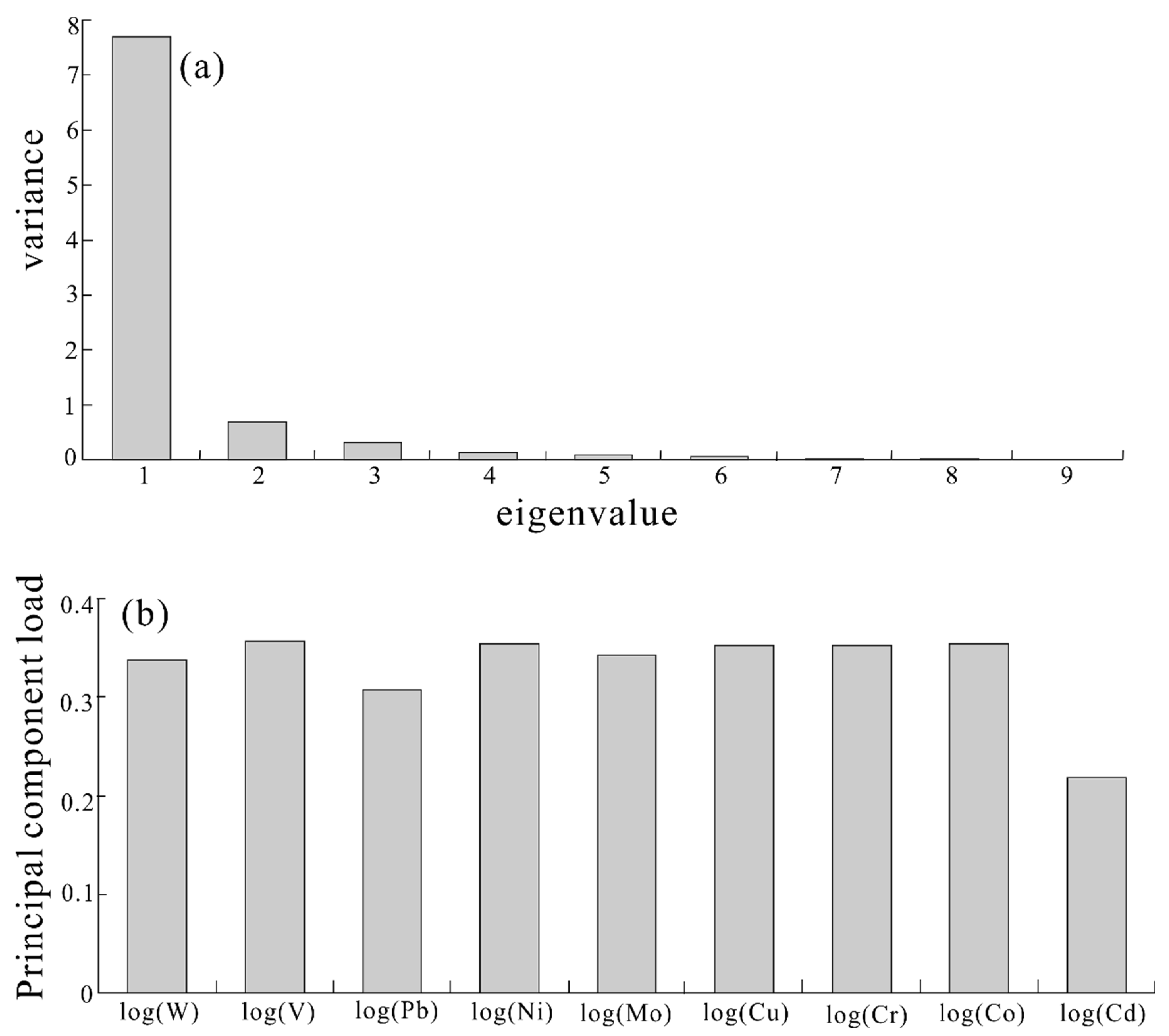
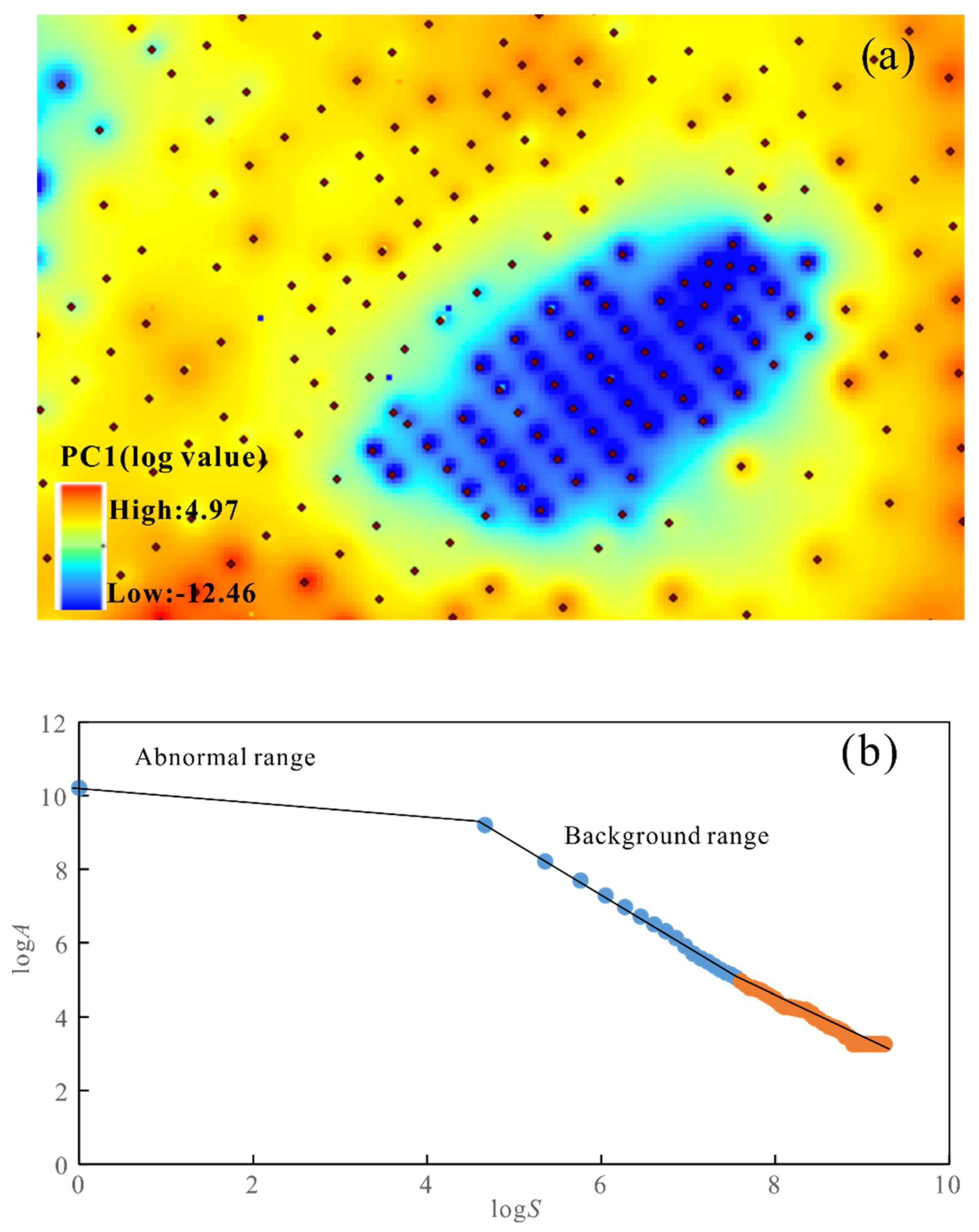
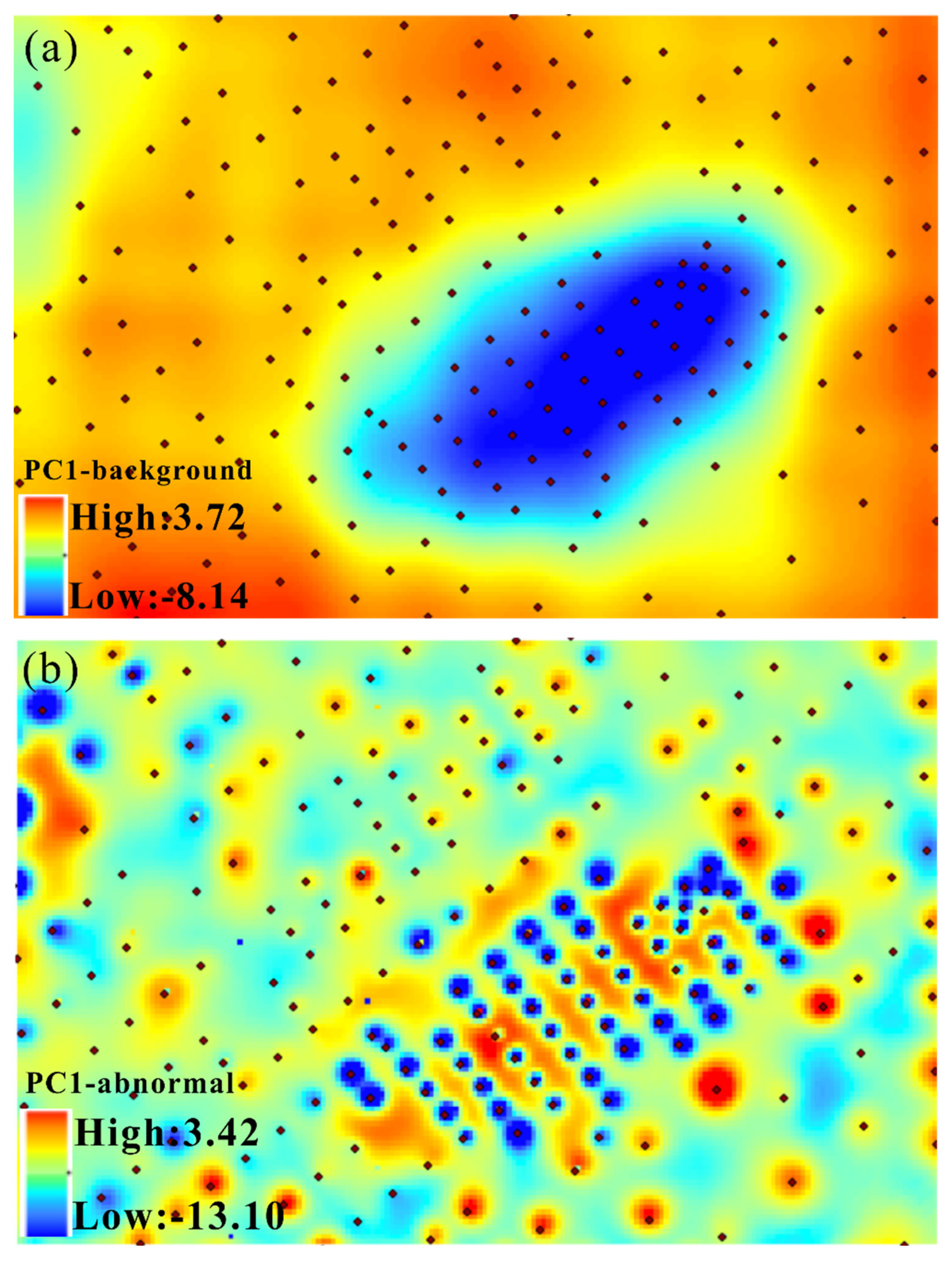
Publisher’s Note: MDPI stays neutral with regard to jurisdictional claims in published maps and institutional affiliations. |
© 2022 by the authors. Licensee MDPI, Basel, Switzerland. This article is an open access article distributed under the terms and conditions of the Creative Commons Attribution (CC BY) license (https://creativecommons.org/licenses/by/4.0/).
Share and Cite
Zhang, Y.; Liu, S.; Zhang, L.; Zhou, Y.; Liang, J.; Lu, J.; Hu, X.; Liu, L.; Chen, L.; Zhang, J.; et al. Application of Singularity Theory to the Distribution of Heavy Metals in Surface Sediments of the Zhongsha Islands. J. Mar. Sci. Eng. 2022, 10, 1697. https://doi.org/10.3390/jmse10111697
Zhang Y, Liu S, Zhang L, Zhou Y, Liang J, Lu J, Hu X, Liu L, Chen L, Zhang J, et al. Application of Singularity Theory to the Distribution of Heavy Metals in Surface Sediments of the Zhongsha Islands. Journal of Marine Science and Engineering. 2022; 10(11):1697. https://doi.org/10.3390/jmse10111697
Chicago/Turabian StyleZhang, Yan, Shiqiao Liu, Li Zhang, Yongzhang Zhou, Jinqiang Liang, Jing’an Lu, Xiaoqiang Hu, Liang Liu, Liang Chen, Jingwei Zhang, and et al. 2022. "Application of Singularity Theory to the Distribution of Heavy Metals in Surface Sediments of the Zhongsha Islands" Journal of Marine Science and Engineering 10, no. 11: 1697. https://doi.org/10.3390/jmse10111697
APA StyleZhang, Y., Liu, S., Zhang, L., Zhou, Y., Liang, J., Lu, J., Hu, X., Liu, L., Chen, L., Zhang, J., Xu, C., & Dong, X. (2022). Application of Singularity Theory to the Distribution of Heavy Metals in Surface Sediments of the Zhongsha Islands. Journal of Marine Science and Engineering, 10(11), 1697. https://doi.org/10.3390/jmse10111697





